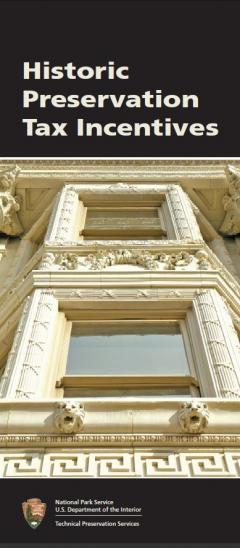Federal Historic Tax Credit
 Important Note: All applications must be submitted by email to jeronimo.roldan@dahp.wa.gov. Please see the Electronic Submission Requirements and National Park Service Guidance below for more information and guidance on digital submissions.
Important Note: All applications must be submitted by email to jeronimo.roldan@dahp.wa.gov. Please see the Electronic Submission Requirements and National Park Service Guidance below for more information and guidance on digital submissions.
What is It?
A 20% Federal income tax credit on the qualified amount of private investment spent on certified rehabilitation of a National Register listed historic building. The National Park Service (NPS) is the agency that administers the program at the federal level for the Internal Revenue Service. DAHP works at the state level to communicate with applicants to ensure successful projects.
The Federal Historic Tax Credit Program (a.k.a. Investment Tax Credits or Rehabilitation Tax Credits) is one of the most useful incentives for encouraging the preservation of the state's historic resources. Since 1977, over 300 projects in Washington totaling over $2 billion dollars have been completed using the Federal Historic Tax Credit Program. Applications have averaged approximately 12 per year, with total investment per year ranging from several million dollars to more than $500 million. The smallest project ever certified was $14,000, while the largest ever certified was over $500 million.
Nationwide, the Federal Historic Tax Credit Program has leveraged $116 billion in private investment since the program's inception in 1976. Over 47,000 buildings have been rehabilitated, creating more than 2.7 million jobs. In FY 2021 alone, there were more than 600,000 housing units rehabilitated or created;185,525 of which are low-moderate income. See the FY 2021 Fiscal year report here.
Which Projects Qualify?
In order for a building owner to claim the tax credit, it must be listed in the National Register of Historic Places, either individually or as a contributing property to a district. If you're unsure about the status of your building, visit our online database of historic properties (WISAARD) to find out! You can also visit this web page to find out how a property can be listed in the National Register of Historic Places.
- The property must be income-producing/commercially depreciable for at least five years following rehabilitation. This may include but not be limited to uses such as hotel, restaurant or bar, retail, office, rental residential, industrial, or agricultural. Owner-occupied residential properties do not qualify.
- The project must be substantial. This means the amount spent on "Qualified Rehabilitation Expenditures"* (QREs) must equal or be greater than the "Adjusted Basis" value** of the property. So the term "substantial" is relative to the building value, not the overall size of the project compared to other buildings or projects.
*Qualified Rehabilitation Expenditures (QREs) can be soft or hard project development costs, and not necessarily reserved for historic character-defining features of a property.
**Adjusted Basis value is an IRS term to determine the "value" of a historic property using this basic formula:
A – B – C + D = adjusted basis, whereas:
A = purchase price of the property (building and land)
B = cost of land at the time of purchase
C = depreciation taken for an income-producing property
D = cost of any capital improvements made since the purchase
- The rehabilitation work must be done according to the Secretary of the Interior's Standards for Rehabilitation (Standards). For further information on how to interpret the Standards, please contact our office, visit the NPS website, or hire a qualified architect or historic preservation consultant. After rehabilitation, the building must be owned by the same owner and operated as an income-producing property for five years.
Application Process
There are three parts to a tax credit application:
Part 1: a building is determined to be eligible for listing on the National Register of Historic Places (and will be listed before the end of the project) or as a building already listed on the Register: either as a group of buildings on a listed property or as a contributing building in a National Register District. A stand-alone building that has previously been individually nominated to the national register does not require a Part 1 application.
Part 2: photo documentation of the building before any rehabilitation has happened and a description of the proposed work to be completed as part of the building's rehabilitation. This application will break the project down into individual components of a building (floors, stairs, brick walls, storefront windows, etc.) and individually describe the proposed work to maintain, restore, or replace these components.
Part 3: photo documentation of the work as completed.
DAHP's role is to guide your successful application. The most important piece of advice we can give applicants is to communicate with us very early in the planning phases of the project. This gives us the opportunity to review the project and identify any areas that would not meet the Secretary of the Interior's Standards. By communicating early into the process, DAHP can help identify potential issues and work with you to develop appropriate solutions. The application process is often quite collaborative, and we are happy to provide guidance at any time in the design process.
DAHP has created this document to provide guidance in completing the application forms.
Applicants are not required to hire consultants to complete an application, but experienced preservation consultants can be helpful in navigating the process, especially for large, complex projects (DAHP does not endorse or keep a list of consultants). Depending on the project, you may need to complete either two or three parts of the application (forms are below). If the subject property contains more than one building, regardless of the age or National Register status of the buildings, the applicant is required to complete the Part 1 application. If the property is listed as contributing to a historic district, the applicant is required to complete a Part 1 application. The only case where a Part 1 is not required would be a property that contains exactly one building that is already individually listed on the National Register of Historic Places.
Here is the process for a successful tax credit application:
- Call DAHP with preliminary ideas for a project. Get feedback and incorporate it into plans. A site visit with DAHP is a great way to convey the current state of a building and the intentions of a rehabilitation project.
- Submit the Part 1 application, if applicable. All application materials should be emailed directly to DAHP. A cover page with an original scanned signature is required for the Part 1 application. When NPS has reviewed the Part 1, they will send a notification letter of their decision via email. This usually takes about 30 days.
- Upon approval of the Part 1 application, NPS offers a free pre-application meeting to discuss the proposed work before submitting the Part 2. This meeting is highly recommended to begin early communication and avoid delays resulting from adjustments to the project.
- Submit the Part 2 application for review. DAHP review can take up to 30 days, depending on workload and leave schedules, but it usually takes less than two weeks. NPS review can take 30 days. When NPS has reviewed the Part 2, they will send a notification letter of their decision via email. Part 2 application reviews often include requests for additional information or conditions for approval, so expect that there may be adjustments to the scope of work.
- Should any changes need to be made during construction, an amendment must be submitted and approved by NPS. If a change is made that is not approved through an amendment, the applicant is at risk of having the project denied.
- When work is completed, coordinate a visit from DAHP to verify the completed work, and then submit a Part 3 application.
Electronic Submission Requirements
As of August 15th, 2023, all applications must be submitted online. If a project was initiated through a hard copy (paper) submission, all subsequent submissions must be through email. Projects started on paper will not continue on paper. Applications must be emailed to jeronimo.roldan@dahp.wa.gov.
These are the requirements for submitting applications and supporting materials electronically:
- Applicants must use the most recent version of the NPS application forms.
- All materials must be submitted as PDFs. Instructions for creating PDF files are available online.
- Application forms must include one of the following types of signatures: Adobe digital ID or an original signature that has been scanned as a .jpeg (or other image) file. Typed signatures will not be accepted.
- Application parts must be saved as individual files. Cover sheets, narratives, site plans/photo keys, photographs, existing conditions drawings, and proposed work drawings should not be combined.
- Application files must be saved using the NPS-required naming conventions.
- Application files must not be larger than 70 MB in size.
- Photographs must follow NPS guidelines for formatting, captions, and photo keys. Photographs should be submitted to DAHP in one PDF file and not uploaded as individual jpegs.
- Drawing files must be flattened when saved as a PDF. Existing and proposed floor plans and elevations must not be combined into one PDF file.
Please contact DAHP with any questions about these requirements. Incorrectly formatted files will be returned, and failing to follow these requirements may result in delays to your project.
National Park Service Guidance
The National Park Service has developed file- and photo-naming conventions and instructions on organizing files for electronic submission. All electronically submitted applications must follow these conventions and instructions. Applicants should download these PDF files for reference in preparing materials for electronic submission.
- Applicant and Project Contact Electronic Submission Workflow
- Electronic File Format Standards and File Naming Conventions
- Photo Naming Conventions, JPEG Requirements and Photo Sheet Example
Application Forms
Technical assistance and application information are available from the State Department of Archaeology and Historic Preservation (DAHP). The office reviews all applications and makes comments and recommendations. Final review and approval is made by the National Park Service (NPS) in its Washington, D.C. office of Technical Preservation Services. Applications must be emailed (or use a file transfer link) to jeronimo.roldan@dahp.wa.gov. The application is three parts for most projects, and the forms are available for download below.
When you click on the form links, the PDF viewer might give you a message that it can't preview the file. Press the Download button and save it to your computer, and it will work fine. Note for Apple users: You must right-click (or double-click, or hold Control and click, depending on your mouse/trackpad settings) and "Save As" or "Download As" on the link below rather than clicking on the link. Clicking on the link will tell you that you must update your Adobe Acrobat Reader.
Note for PC users: The application forms are fillable PDFs. Download and "Save As" under a new file name before filling out the form.
NPS Instructions for Completing Historic Preservation Certification Application
- Part 1 (Evaluation of Significance)
- Part 2 (Description of Rehabilitation)
- Amendment Form - use this form to get approval for changes or provide additional information not included in the original Part 2 submittal
- InDesign Photo template (requires Adobe InDesign) - Template that can be used for photo pages
- Part 3 (Request for Certification of Completed Work)
All fees for the review of applications are paid through Pay.gov.
National Park Service (NPS) approval of applications and amendments to applications is conveyed only in writing by duly authorized officials of the Federal Government. The NPS certification decision is made on the basis of the descriptions in the application form. In the event of any discrepancy between the application form and other supplementary material submitted with it (such as architectural plans, drawings, and specifications), the application form takes precedence. Photographs, architectural plans, drawings, and other materials submitted with the application become the property of the NPS and may be reproduced by it without permission.
Application Resources
Below are some resources to help you through the application process. But always feel free to contact us directly if you have specific questions!
| 1-1 National Register and the Tax Credit Program | 1-2 Planning a Successful Tax Credit Application |
| 2-1 Federal Historic Tax Credit Program Requirements | 2-2 Storefronts, Windows & Rooftop Additions - Meeting the Standards |
Powerpoint Slides
This 2018 presentation includes information about tax credit investment structuring. Click the image to download the PDF file.
The Seismic Retrofit of Historic Buildings Video Series
The historic tax credit program is frequently used to offset the cost of seismic upgrades to historic buildings. Seismic interventions can be fairly invasive, but there is usually a way to incorporate these changes into historic structures. There are six videos to this series, sponsored by APT and DAHP, that include many case studies of successful seismic upgrades to historic buildings.
Additional Incentives
Special Valuation
Property owners in Certified Local Government communities often take advantage of Special Valuation, a local property tax incentive. Contact your local historic preservation officer to find out if Special Valuation is available in your area.
New Market Tax Credit
The New Markets Tax Credit (NMTC) Program permits taxpayers to receive a credit against Federal income taxes for making qualified equity investments in designated Community Development Entities (CDEs). Substantially all of the qualified equity investment must, in turn, be used by the CDE to provide investments in low-income communities. The credit provided to the investor totals 39% of the cost of the investment and is claimed over a seven-year credit allowance period. In each of the first three years, the investor receives a credit equal to five percent of the total amount paid for the stock or capital interest at the time of purchase. For the final four years, the value of the credit is six percent annually. Investors may not redeem their investments in CDEs prior to the conclusion of the seven-year period.
National Trust Community Investment Corporation
Since its inception in 2000, NTCIC has provided nearly $2 billion in capital for more than 200 HTC, NMTC, ITC, and LIHTC investment transactions, representing more than $7 billion in total development costs. NTCIC is the historic tax credit industry's leading advocate for improving and expanding the use of federal and state HTCs, having organized and chaired the Historic Tax Credit Coalition since 2009. National Trust Community Investment Corporation (NTCIC) enables tax credit equity investments that support sustainable communities nationwide. NTCIC places qualified tax credits for federal and state historic (HTC), new markets (NMTC), solar (ITC), and low-income housing (LIHTC) projects.
Irvin Henderson Main Street Revitalization Fund
Also a product of the NTCIC, the Irvin Henderson Main Street Revitalization Fund provides tax credit financing to support transformational historic rehabilitation projects specifically located in low-income Main Street communities.
C-PACER (Commercial Property Assessed Clean Energy and Resilience)
C-Pacer allows property owners to access financing for qualifying energy efficiency, renewable energy, water conservation, and resiliency improvements for their buildings. The financing stays with the property, rather than with the building owner. Programs like C-PACER have enabled financing for over 2,000 property owners in 24 states and the District of Columbia. PACE financing is a financing tool that enables building owners to pay for critical building improvements that make their properties more valuable by reducing operating expenses, improving the health of occupants, and strengthening long-term sustainability. PACE financing provides a way for local governments and private lenders to cooperate on loans secured by the property tax obligation, similar to a local improvement district. The debt does not appear as an obligation on the building owner's balance sheet, and the repayment obligation stays with the property rather than the owner whenever the building is sold.
C-PACER Workshop Presentation Video presented by the Washington Trust for Historic Preservation
Contacts:
- Richard Martinez, RMartinez@kitsapbank.com
Senior Vice President and Director, Municipal & Specialty Banking, Kitsap Bank - Banu Erdim, BErdim@kitsapbank.com
Sustainability and ESG Analyst, Kitsap Bank - John MacLean, jmaclean@eefinance.net
President, Energy Efficiency Finance Corporation




